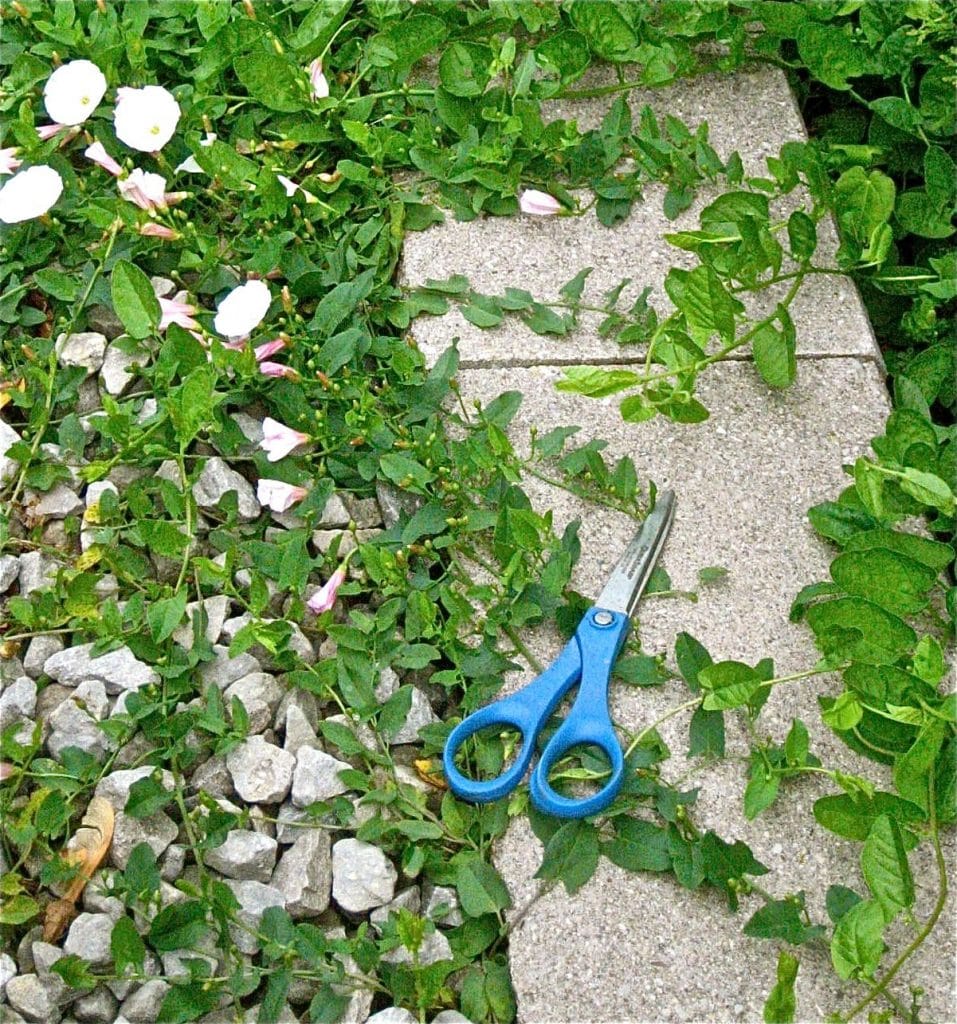
Meet my nemesis: Convolvulus arvensis, commonly called field bindweed. I commonly call it something much, much worse.
Related to the lovely annual morning glory, field bindweed is a creeping perennial with roots that can penetrate up to 5 metres and produce more than 500 seeds per plant per year. If that doesn’t scare you, consider that bindweed seed can remain viable in soil for 30-50 years. It’s also drought tolerant, prefers heavy clay soils and can easily poke up through mulches because of its vigorous climbing habit.
A few years ago, I mistakenly ignored a small outbreak of bindweed between our gravel driveway and a cedar hedge. It quickly got out of hand as I worked on other more gratifying gardening projects and I now rue my lack of vigilance. Thank goodness there is the width of a gravel driveway between this thug and the front garden.
My penance is that I now spend more than an hour every two weeks throughout summer methodically snipping the stems at ground level when they reach 15 cm and discarding every morsel I remove. I cut, rather than pull the plants out, to avoid breaking roots underground. (It’s impossible to remove those long roots at one go!) Broken roots develop adventitious buds and shoots in just a few weeks which would only exacerbate this woeful situation. Sometimes more than two weeks elapse between my Bindweed Eradication Sessions (as the photo here testifies), but I am diligent about removing flowering vines before they set seed. In open areas, excluding light with a layer of black plastic for a year or two would thwart it, too.
Everything I’ve read says that if I keep up this regime for, oh, at least 3 or 4 years, the root reserves will decline as a result of reduced photosynthesis. I garden in hope.









I used to weed wack this before I realized what it was I have it in one side of my garden terrible I didn’t plant there this year and weed whacked and sprayed with commercial grade vinegar, then my goats were turned out for a bit but I am noticing some of it in the other side of my garden. I’m at a loss of what to do. There is way too much of it to actually cut with scissors
I hate this stuff I have 4 outbreaks IN my house it has got through the foundations, it’s all over my front and back garden. The outbreaks are normally in my front room as I have a flower bed under the window outside, but this year is has come through up the stairs and on that side I have a concrete path on the outside and it’s came through on the third step.
Do you advocate cutting back all weeds? I have been reading from Larry Weaner’s book- “Garden Revolution”, and he advocates cutting back 1. So weeds do not set seed and 2. because pulling weeds disturbs the seed bank lying below ground- allowing dormant weed seeds to germinate even more.
I’ve been using this method in my backyard for the last few years and can testify that the amount of bindweed there is minimal. I only get around really weeding my backyard a few times a season.
I have battled this as well for years. I have recently discovered it under my deck. Oh my I can’t believe its trying to come to the back yard. Why is cutting better?
I found bindweed in my front garden and it’s tangled around my plants. Is this a type of weed that chokes out other plants? One of our plants that grew well last year is not looking very well this year.
Good luck with the bindweed. I’ve been battling it for 20 years. At least I got it out of parts of the lawn and the paved driveway.
I wish I’d known this several painstaking days ago. I’ve been pulling that stuff out from all over my lawn, fence, garden… It’s even grown like white spaghetti under my new shed.
Cutting will be the thing I do from now on. And blocking the sun where I can. Thanks!
Hi Margaret (Aug 23): Bindwind is tenacious, that’s for sure. It may take a while (a few years?) to get it under control, but persistence will help. Even pulling, to some degree–whatever you can do to weaken its reserves.
You’re right, Helen! I peeked around on their side of the hedge and saw a few strands. Lucky for them, their side is in shade. The bindweed likes my sunny side.
Good tips, Beckie. Make sure the neighbour on the far side of the hedge does it, too. Those bindweed root systems can stretch out for metres!